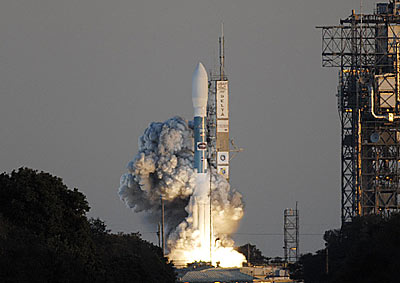UC Berkeley Press Release
 |
A Delta II launches the THEMIS spacecraft NASA/KSC image |
Successful launch of UC Berkeley's THEMIS satellites positions NASA mission to answer key questions about Earth's auroras
CAPE CANAVERAL – After a picture-perfect launch into clear, blue skies at 6:01 p.m. EST Saturday, Feb. 17, the five THEMIS probes are healthy and in their expected orbits, according to University of California, Berkeley, physicist and mission principal investigator Vassilis Angelopoulos.
"Based on telemetry received by UC Berkeley's ground station, they look really good," he said.
 Launch day for THEMIS: Scientists from UC Berkeley's Space Sciences Lab and NASA launch the rocket carrying five THEMIS satellites into space. (14Mb)
Launch day for THEMIS: Scientists from UC Berkeley's Space Sciences Lab and NASA launch the rocket carrying five THEMIS satellites into space. (14Mb)
 Pre-launch press conference: THEMIS project manager Peter Harvey describes building the THEMIS satellites. (13Mb)
Pre-launch press conference: THEMIS project manager Peter Harvey describes building the THEMIS satellites. (13Mb)
 Satellite antenna: Electric field instrument lead John Bonnell demonstrates the THEMIS satellite antenna. (12Mb)
Satellite antenna: Electric field instrument lead John Bonnell demonstrates the THEMIS satellite antenna. (12Mb)
 Ground-based observatories: Research physicist Stephen Mende demonstrates the camera and computer equipment that track auroras from the ground for the THEMIS mission. (5Mb)
Ground-based observatories: Research physicist Stephen Mende demonstrates the camera and computer equipment that track auroras from the ground for the THEMIS mission. (5Mb)
 Auroras: Fast-motion video of auroras, courtesy of SOLARMAX-Heliograph. (7Mb)
Auroras: Fast-motion video of auroras, courtesy of SOLARMAX-Heliograph. (7Mb)
THEMIS mission overview 1.17.2007 press release
"The THEMIS mission will make a breakthrough in our understanding of how Earth's magnetosphere stores and releases energy from the sun and also will demonstrate the tremendous potential that constellation missions have for space exploration," said Angelopoulos.
The satellites won't be in a position to answer this question until next winter, because they must coast into the proper orbits to allow them to detect electrical activity in space and link this to auroral outbursts via a network of 20 ground observatories spanning Canada and Alaska. Until then, according to David Sibeck, THEMIS project scientist from NASA Goddard Space Flight Center, THEMIS will collect data that will help improve our understanding of the Van Allen radiation belts surrounding Earth and will show how energy from the sun enters the Earth's magnetic field on the daytime side and is funneled to the nighttime side to create auroras.
The findings from the mission may help protect commercial satellites and humans in space from the adverse effects of particle radiation.
As of 10 p.m. EST Saturday, however, the probes were coasting in Earth orbit as UC Berkeley's Mission Operations Center ran them through tests to make sure they survived the launch successfully. Instrument scientists will turn on and characterize the instruments during the next 30 days, and the center will then assign each spacecraft a target orbit within the THEMIS constellation based on its performance. Mission operators will direct the spacecraft to their final orbits in mid-September so that, during the winter, they will line up in the Earth's shadow every 4 days to pinpoint the position of auroral substorm initiations.
The THEMIS launch, which was the responsibility of NASA's Launch Services Program at the Kennedy Space Center, was aboard a Delta II rocket from Pad 17-B at Cape Canaveral Air Force Station, Fla. The United Launch Alliance of Denver provided launch service
The spacecraft separated from the launch vehicle approximately 73 minutes after liftoff. By 8:07 p.m. EST, after the five probes had flown over UC Berkeley's ground-based radio antenna, mission operators at UC Berkeley commanded and received signals from all five spacecraft, confirming that they had separated properly from the carousel that Swales Aerospace had designed to fling them into orbit.
While only two were confirmed healthy on the constellation's first flight over the ground antenna, the other three were confirmed healthy on the second flyover.
THEMIS is an Explorer mission, which is managed at Goddard by the Explorer Program Office at Goddard.
"I am proud to manage the fifth medium class mission of the Explorer Program," said NASA's Willis S. Jenkins, the THEMIS program executive. "As we seek the answer to a compelling scientific question in geospace physics, we are keeping up the tradition that began with Explorer I."
The Space Sciences Laboratory at the UC Berkeley is responsible for project management, space and ground-based instruments, mission integration, mission operations and science. Swales Aerospace of Beltsville, Md., built the THEMIS probes. THEMIS is an international project conducted in partnership with Germany, France, Austria and Canada.
For more information about the THEMIS mission and imagery, visit http://www.nasa.gov/themis or go to the THEMIS mission Web site.

